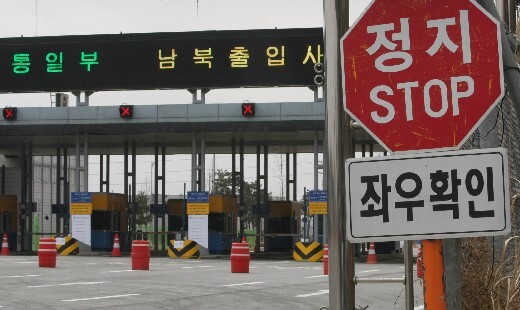hankyoreh
Links to other country sites 다른 나라 사이트 링크
North cuts off military communications with South

Early March 9, North Korea declared it is cutting off the military hotline between North and South during Seoul’s “Key Resolve” joint military exercises with the United States, and immediately began blocking the passage of South Korean personnel to and from the Gaeseong (Kaesong) Industrial Complex. Some 726 Southerners were scheduled to visit the North later that day but were unable to go, while roughly 80 Southerners set to return from Gaeseong were unable to do so on schedule. Border crossings have been taking place after travel plans were conveyed using the communication line that exists between the militaries of both sides, and the loss of that channel of communication means the necessary information cannot be conveyed.
Despite this, the Seoul government seems halfhearted in its management of the situation.
Later the same morning the South’s Ministry of Unification issued a spokesperson’s statement. It was a little stronger in tone than previous comments by the ministry spokesman in response to other North Korean moves meant to pressure the South.
But that was all. And Unification Ministry statements continue to be all too weak in attaining the desired effects. The statement of March 9 says the South Korean government “will swiftly take the necessary measures for the safety of our personnel in Gaeseong and at Mount Geumgang (Kumgang) and for the smooth continuance of projects there,” but the only action it took was to indirectly ask Pyongyang, through the Gaeseong Industrial Complex Management Committee, to allow Southern personnel to cross the border. Reportedly, the North Korean counterpart of committee said it is “waiting for instructions from above” and has made no further response.
Seoul still is not considering retaliatory moves. It is worried about the safety of the Southerners still in Gaeseong if the situation were to escalate, and furthermore there have been no signs of a potential military clash, since the North Korean military has not been observed in any unusual activity. The assumption is also that the North will not let the situation get so out of hand that it would look like it is deliberately holding Southerners, something that could bring international wrath and military action on the part of the United States and the South.
The problem, then, is that other than making demands and requests, Seoul has no other means at its disposal. Inter-Korean relations have been worsening for some time now, and almost all available channels have broken down. It has almost exhausted non-military means for pressuring Pyongyang for change, like with rice and fertilizer.
Pyongyang has continued with a barrage of measures mean to step up pressure on Seoul since the inauguration of President Lee Myung-bak. It expelled Southern officials in the North, put restrictions on land travel across the border, annulled various military agreements and warned about the possibility of armed clashes, and now has halted Southern civilian air travel through its airspace during the Key Resolve exercises.
Each and every time, the Lee administration’s strategy has been to deliberately ignore what has happened, deciding “not to get excited or upset” at “each little North Korean threat.”
Now that those threats have revealed themselves in the form of concrete action, however, Seoul is left with its hands tied, unable to do much more than watch.
Please direct questions or comments to [englishhani@hani.co.kr]
Editorial・opinion
![[Editorial] Penalties for airing allegations against Korea’s first lady endanger free press [Editorial] Penalties for airing allegations against Korea’s first lady endanger free press](https://flexible.img.hani.co.kr/flexible/normal/500/300/imgdb/original/2024/0502/1817146398095106.jpg) [Editorial] Penalties for airing allegations against Korea’s first lady endanger free press
[Editorial] Penalties for airing allegations against Korea’s first lady endanger free press![[Editorial] Yoon must halt procurement of SM-3 interceptor missiles [Editorial] Yoon must halt procurement of SM-3 interceptor missiles](https://flexible.img.hani.co.kr/flexible/normal/500/300/imgdb/child/2024/0501/17145495551605_1717145495195344.jpg) [Editorial] Yoon must halt procurement of SM-3 interceptor missiles
[Editorial] Yoon must halt procurement of SM-3 interceptor missiles- [Guest essay] Maybe Korea’s rapid population decline is an opportunity, not a crisis
- [Column] Can Yoon steer diplomacy with Russia, China back on track?
- [Column] Season 2 of special prosecutor probe may be coming to Korea soon
- [Column] Park Geun-hye déjà vu in Yoon Suk-yeol
- [Editorial] New weight of N. Korea’s nuclear threats makes dialogue all the more urgent
- [Guest essay] The real reason Korea’s new right wants to dub Rhee a founding father
- [Column] ‘Choson’: Is it time we start referring to N. Korea in its own terms?
- [Editorial] Japan’s rewriting of history with Korea has gone too far
Most viewed articles
- 160% of young Koreans see no need to have kids after marriage
- 2Months and months of overdue wages are pushing migrant workers in Korea into debt
- 3[Editorial] Penalties for airing allegations against Korea’s first lady endanger free press
- 4[Guest essay] Maybe Korea’s rapid population decline is an opportunity, not a crisis
- 51 in 3 S. Korean security experts support nuclear armament, CSIS finds
- 6[Reporter’s notebook] In Min’s world, she’s the artist — and NewJeans is her art
- 7Bills for Itaewon crush inquiry, special counsel probe into Marine’s death pass National Assembly
- 8S. Korea discusses participation in defense development with AUKUS alliance
- 9Japan’s standards for use of preemptive counterstrike against N. Korea remain unclear
- 10Trump asks why US would defend Korea, hints at hiking Seoul’s defense cost burden